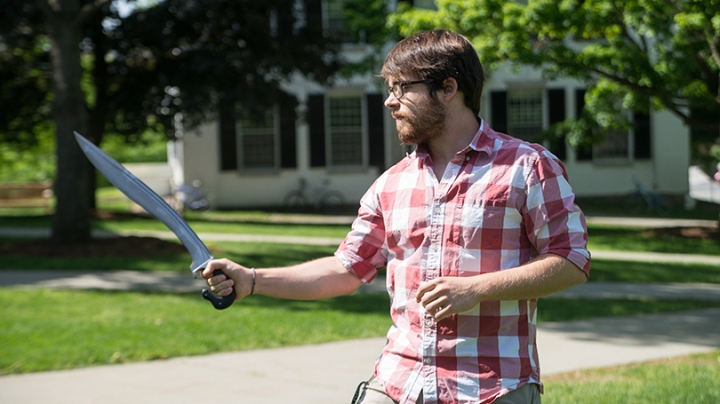Thomas Rover ’16 is a student of warfare, specifically in ancient Greece, but philosophically he is a pacifist. This seeming contradiction lies in a lifelong fascination with weaponry, swords in particular, accompanied by a rejection of violence as a means of conflict resolution.
“Violence does not resolve the cause of the conflict,” says the classics major. “It only deals with the symptoms.”
His pacifism notwithstanding, Rover turned to an implement of violence—an ancient sword—to further his honors thesis research into the military tactics among the Greeks of antiquity. Using a replica weapon, he was able to test its suitability under simulated battlefield conditions and gain insight into warfare among the ancients.
“I grew up with Star Wars and I am a fencer,” Rover says. “But I don’t believe in armed combat and I don’t believe it solves problems. I am fascinated by it because, despite the fact that we have so many linguistic, diplomatic, and empathetic skills to solve problems of the world, we still resort to armed combat.”
A native of Westchester County, N.Y., with a father who is a ’77, Rover early on gained more than a passing familiarity with Dartmouth.
“I have been coming up to Dartmouth every Columbus Day since I was a very small child,” he says, “but when I came up for Dimensions weekend, I saw it through a new set of eyes. I wasn’t just seeing my Dad’s school.”
Now a student of classical archaeology at the College, Rover last year explored with his adviser Roger Ulrich possible topics for his undergraduate honors thesis. Rover broached the idea of analyzing the kopis—an odd type of Greek sword, visually striking, and “not what you would expect a sword to look like,” he says. “It is unmistakable and, to the best of my knowledge, no one had ever devoted any serious study to it.”
Ulrich approved, and referred him to Paul Christesen, “on the Greek side of the department,” who told Rover that he would probably have to make one “because no one had ever done so and it would therefore constitute new evidence in an extremely old field.”
Flying to London in October 2015, Rover spent a week at the British Museum in London, making first-hand observations of the eight examples in its collections. “I measured them, weighed them, took hundreds of pictures and, using that data, I was able to give New Jersey master swordsmith Mark Morrow all he needed to fabricate a modern example,” he says.
“I am actually creating something physically and using it to contribute to the field, not something we often have an opportunity to do as undergraduates,” says Rover.
“The sword became a tool I used to help disentangle some pretty gnarly scholastic arguments,” he says. “In the field of ancient Greek warfare studies, it comes down to understanding infantry formations and the roles their weapons played.”
There are two schools of thought, he says. “The traditionalists feel that Greeks fought in densely packed and ordered formations, with rows of men armed with spears and shields, moving forward in lock-step. They also carried the kopis, which could be brought to bear as a weapon on the perimeters.
“The revisionist school thinks they fought a lot more like the way Homer describes, where you have champions running out in front of a more loosely, fluid formation, chucking spears at each other and engaging in one-on-one combat.”
He says the arguments between these two schools have not changed much in recent decades. “I am trying to use what I find with this sword to help unpack and add some new evidence to speed the process toward resolution.”
Rover took his kopis and tested it in a variety of scenarios, emulating the actions of the Greek hoplites, as the infantrymen were known. “The sword can actually tell us a great deal about the realities of combat. If we can figure out what the sword was meant to be used for, we can find that situation that would only arise in one type of battlefield action,” he says.
“Through handling the sword in conjunction with a replica shield, I found out that the sword was designed for a single, very specific type of motion—a chopping action that could not have taken place in a battle as the revisionists would envision it,” says Rover.
The kopis is short, about two feet in length—too short to serve as an offensive weapon in single combat—and used with a shield, its reach is further restricted.
“I believe my conclusions, based on experimental results, support the contentions of the traditionalists, and these are corroborated by the iconographic and literary evidence as well,” he says. He plans to submit part of the thesis for publication in an archaeological journal.
“I am going on a dig in Israel this summer, and then I’m looking for a job as a Latin teacher for a few years before I go to grad school for archaeology,” he says.

